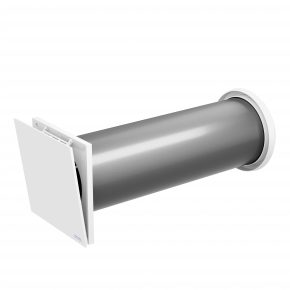
Vent-Axia: Heat and Buildings Strategy Requires Ventilation for Healthy Indoor Environment
Leading British ventilation manufacturer, Vent-Axia, welcomes the Government’s ‘Heat & Buildings Strategy’ that was published ahead of COP 26.
The company is delighted the document identifies the importance of air quality and ventilation in the Government’s vision for a greener future. The strategy brings together the Government’s work on energy efficiency and clean heat, laying the foundations for Net Zero buildings in the UK by 2050.
However, it also includes air quality within its five core principles to guide action in the 2020s and longer-term transformation to Net Zero. Containing its own sub-section entitled ‘Improving Air Quality’ the document recognises the vital importance of reducing the build-up of harmful levels of air pollution within homes.
This can occur if ventilation is not considered when improving the air tightness of a home to improve its thermal efficiency. The document states: “Adequate ventilation is required to ensure a healthy indoor environment and prevent creation of increasingly airtight spaces, which may trap pollutants indoors.”
COVID-19 has highlighted to us all the importance of ventilation for good health. The strategy recognises this and that improving the energy performance of our buildings, without creating airtight spaces, presents ‘an opportunity to ensure our buildings provide warm, well-ventilated spaces and healthy environments from which people can live and work’. This builds on the Government’s Clean Air Strategy, which highlighted the importance of clean air in the home.
The Clean Air Strategy set out how the Government aims to tackle all sources of air pollution with indoor air quality (IAQ) a key part of this. As such, the document proposed a number of simple measures to reduce air pollutants in the home, including regularly ventilating dwellings.
 Lena Hebestreit, Marketing Manager at Vent-Axia, comments: “We welcome the Government’s Heat and Buildings Strategy since at Vent-Axia we are committed to public health by improving indoor air quality through ventilation while at the same time making sustainable attainable for our customers.
Lena Hebestreit, Marketing Manager at Vent-Axia, comments: “We welcome the Government’s Heat and Buildings Strategy since at Vent-Axia we are committed to public health by improving indoor air quality through ventilation while at the same time making sustainable attainable for our customers.
“The Heat and Buildings Strategy sets out a pathway for clean heat to lay the foundations for Net Zero without subordinating the vital importance of good indoor air quality to provide healthy indoor environments
“When making a home or building more airtight through energy efficiency measures such as insulation it is essential to consider improving ventilation too. While increasing the airtightness of a building reduces the amount of heat escaping improving its thermal efficiency, without sufficient ventilation indoor air quality can deteriorate and occupants can also have ongoing issues with condensation and mould.
“In existing homes, it is now possible to have the best of both worlds by retrofitting single room heat recovery ventilation products, like our Lo-Carbon Heat Save, which recover the warmth from outgoing air to heat incoming air to avoid heat loss, reduce energy bills for households, and provide good indoor air quality for the occupant.”
Vent-Axia is delighted the Heat and Buildings Strategy aims to reduce the carbon footprint of homes and buildings in the UK since the company is committed to helping make sustainable attainable for its customers by taking action to reduce its environmental impact.
There are 30m buildings in the UK, which are responsible for around 30% of the UK’s emissions with the vast majority of them resulting from heating: 79% of buildings emissions and about 23% of all UK emissions. However, improved ventilation must go hand-in-hand with a low carbon heating transformation and energy efficiency measures to avoid poor indoor air quality and subsequent health impacts.
When it comes to improving the thermal efficiency of buildings improving ventilation must be considered too, otherwise if a home is made more air tight to save energy it can end up with indoor air pollution, condensation and mould.
Improving a home’s energy efficiency by making it more airtight reduces the amount of heat escaping and so saves energy, but is also limits the amount of air that naturally passes through gaps in a building. Many homes and buildings rely on this ‘natural infiltration’ to provide fresh air and to remove air pollutants and moisture in indoor air, which can be harmful to health.
Since 1936, Vent-Axia has been working hard to provide ventilation solutions to improve IAQ for homes and buildings. For new build homes, Vent-Axia’s Lo-Carbon Sentinel Kinetic Advance Mechanical Ventilation with Heat Recovery (MVHR) offers continuous ventilation with up to 93% heat recovery [in line with Product Characteristics Database (PCDB) data] and is designed with wireless commissioning to encourage best practice and help ensure ventilation performs as designed.
In total 132m kilowatts of energy are saved with the Vent-Axia MVHR range each year. A vital part of an MVHR system is its filters. Inside an MVHR unit, fresh incoming air passes through a filter to remove pollen, debris and products of pollution. Filters up to ISO ePM2.5 70% (F7 grade) ensure even homes in heavily urbanised areas can filter out most impurities, up to and including PM2.5 particles, for example diesel particulates.
For private energy efficiency refurbishments, the Vent-Axia Lo-Carbon Heat Save is designed to offer either single room or whole house heat recovery ventilation solution for existing homes. The decentralised heat recovery ventilation unit is ideal for retrofitting, providing extract and supply ventilation to improve IAQ and supply fresh air to rooms as part of a modular system.
Achieving up to 84% heat recovery, the Heat Save uses the warmth from outgoing air to heat incoming air to avoid heat loss and to reduce energy bills for households.
For social housing refurbishments, Positive Input Ventilation (PIV), such as Vent-Axia’s Lo-Carbon PoziDry Pro and Lo-Carbon PoziDry Compact Pro offer filtration up to ISO ePM2.5 70% (F7 grade). Designed to improve IAQ and prevent moisture build-up within social housing properties, the PIV range provides a highly effective solution to help households and landlords control condensation and mould, as well as offering high levels of air filtration.
For commercial buildings the popular T-series extract/intake fan offers both window and wall options, as well as Lo-Carbon models, it is both durable and reliable. Meanwhile, Vent-Axia’s ACM inline fans also offer installation flexibility as they can be installed with either rigid or flexible ducting and are dimensionally more compact than alternatives, making them ideal for many ducted applications.
However, it is the Sentinel Totus² D-ERV that offers heat recovery demand ventilation system that provides an effective solution to both; ensuring good ventilation and so improved IAQ, plus it offers a range of sensors, such as CO2, PIR occupancy detection, humidity or temperature which are employed to determine the room’s air quality, adjusting the ventilation requirements automatically and managing the system’s ventilation rates accordingly.
Latest news

30th April 2025
Digital Construction Week announces seminar programme for its landmark 10th edition
Digital Construction Week (DCW) returns to ExCeL London on 4 – 5 June 2025 with its most impactful programme yet. It brings together the best and brightest from across AECO, for two days of practical learning and idea sharing.
Posted in Articles, Building Industry Events, Building Industry News, Building Products & Structures, Building Services, Building Systems, Exhibitions and Conferences, Information Technology, news, Restoration & Refurbishment, Retrofit & Renovation, Seminars
29th April 2025
Senior pledges to ‘bee’ part of the solution with new biodiversity initiative
Senior Architectural Systems has installed its first on-site beehive, marking another step forward in its commitment to sustainability and biodiversity.
Posted in Articles, Building Industry News, Building Products & Structures, Building Services, Curtain Walling, Doors, Glass, Glazing, Innovations & New Products, news, Restoration & Refurbishment, Retrofit & Renovation, Sustainability & Energy Efficiency, Walls, Windows
29th April 2025
West Fraser range delivering key benefits for South-East carpentry company
An experienced carpenter and building site manager who has recently set up his own company is using high performance panel products from the West Fraser range.
Posted in Articles, Building Industry News, Building Products & Structures, Building Systems, Case Studies, Garden, Restoration & Refurbishment, Retrofit & Renovation, Sustainability & Energy Efficiency, Timber Buildings and Timber Products
29th April 2025
CPD Courses Available Online From Ecological Building Systems
Ecological Building Systems, a leading supplier of natural building products for sustainable construction, has revealed its comprehensive CPD programme for the year ahead.
Posted in Articles, Building Industry Events, Building Industry News, Building Products & Structures, Building Services, Continuing Professional Development (CPD's), Information Technology, Innovations & New Products, Insulation, Restoration & Refurbishment, Retrofit & Renovation, Seminars, Sustainability & Energy Efficiency, Training, Walls, Waste Management & Recycling
 Sign up:
Sign up: